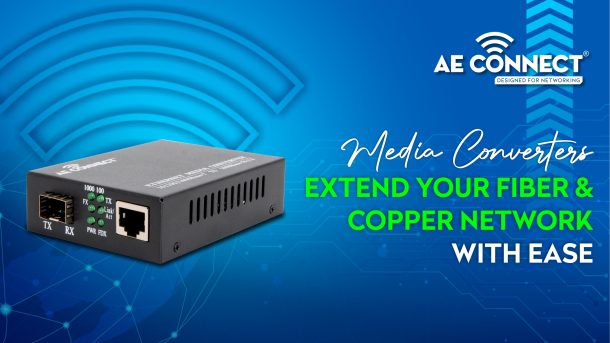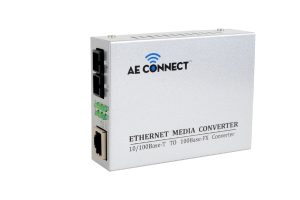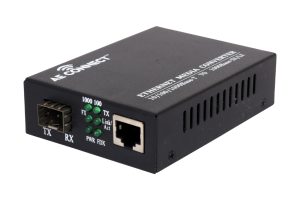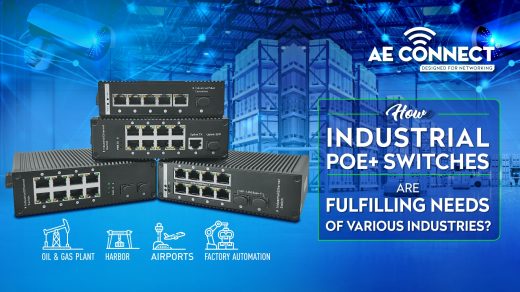High-speed network transmission through long distances has always been a big challenge for network suppliers for many years. This becomes more challenging when it comes to transmitting data through copper networking solutions. We can transmit data only several feet through copper cables. For long distances, fiber optic cabling infrastructure is a necessity. If the whole networking infrastructure is equipped with copper networking solutions, replacing networking equipment from copper solution to fiber-optic solutions not only puts pressure on our pockets but also is not a convenient method to make the existing infrastructure useful. Media Converters play a crucial role here to make any existing cabling infrastructure efficient and compatible for any type of network transmission whether it is copper or fiber.
What are Media Converters?
Media Converters are simple networking devices that allow connecting to different media types such as twisted pair cables with fiber-optic cables. In the 1990s these media converter were introduced to interconnect fiber optic cabling-based systems with existing copper-based, structured cabling systems. Transport services to enterprise customers and Metropolitan area network (MAN) access also uses the media converter
What types of media conversion are possible through Media Converters?
There are different types of data communication protocols supported by media converters including Ethernet, Fast Ethernet, Gigabit Ethernet as well as multiple cabling types such as twisted pair, coax, single-mode and multi-mode fiber optics. From small standalone devices and PC card converters to high port-density chassis systems, media converter are available in various ranges that offer the most advanced features for network management.
Simple network management protocol enables sending traps to network managers in the event of a link loss on copper port or a fiber break, monitoring chassis environmental statistics and proactive management of link status. Connecting different LAN media, modifying duplex and speed settings comes with ease through media converter. It is possible to connect switching media converters to different speed network segments such as half-duplex hubs that can be connected to 100BASE-TX Fast Ethernet network segments over 100BASE-FX fiber segments.
Media converters are useful in connecting multiple LANs to form one large area network that spans over a limited area while expanding the reach of the LAN to span over multiple locations. It is not possible to extend the network transmission with copper-based old networks but by using media converter this problem can be resolved easily.
In situations where fiber is in limited supply or expensive, wavelength-division multiplexing (WDM) technology is beneficial in Local Area Networks. Along with dual strand fiber converters with separate receive and transmit ports there are also single strand fiber converters that allow extending full-duplex data transmission for long distances over a single fiber optic cable. Providing a gradual migration path, from copper to fiber is another added advantage of media conversion. Fiber connections can reduce electromagnetic interference and greatly extend the reach. Ordinary switches not supporting fiber can use fiber media converter to connect to fiber networks that ultimately provide a superfast network transmission over long distances.
Also Read:
- How IoT Is Shaping The Future Of The World? Let’s Discuss
- Dreams, Challenges & Empowering Make in India: The Journey of AE Connect
- Know More About The Power of Next-gen Gigabit PoE Injector
Advantages of using Media Converter:
- Extend Network Transmission:
Only limited data transmission is allowed with copper-based Ethernet connections. The Ethernet to fiber conversion becomes necessary for network transmission over long distances. With the help of media converters, extending network transmission becomes easier, reliable and affordable.
- Utilize the Potential of Existing Equipment:
While protecting investment in existing copper-based networking equipment, migrate a local network to fiber by using media converter. It allows saving more cost and valuable time for your business without compromising the output of networking infrastructure.
- Protect Data from Electromagnetic Interference:
Corruption of data over copper-based Ethernet links was the biggest challenge due to electromagnetic interferences or EMI. Network transmission through fiber optic cable is perfectly immune to electromagnetic interference. Fiber optic network transmission ensures optimal data transmission and networking performance.
- Speed Conversion:
If you want to convert link speed from 10Mbps to 100Mbps or from 100Mbps to 1000 Mbps, media converter should be your first choice. For a seamless networking experience and a blazing data transmission, media conversion is the most affordable way to upgrade your existing networking infrastructure.
- Power over Ethernet:
To simplify the installation of Wi-Fi access points, IP Cameras and other PoE powered devices, using PoE Media Converter eliminate the need for a local AC power circuit.
What are the different types of Media Converter?
Media Converters Used For Copper-to-Fiber Media Conversion
Copper-to-fiber media converters allow connecting copper-based Ethernet equipment over a fiber-optic networking link to extend the links over long distances with fiber-optic cable. This makes the networking system future proof with additional bandwidth capacity and protects data from electromagnetic interference.
Media Converters Used For Fiber-to-Fiber Media Conversion
Whenever conversion from one wavelength to another is required, fiber-to-fiber media conversions are used to connect and support the different fiber-optic networks. Media converter provide connectivity between single-mode and multi-mode fiber as well as between single and dual fiber.
Media Converters Used For PoE Media Conversion
For reliable and cost-effective fiber distance extension to PoE-powered devices can only be achieved with PoE media converters. Video Conferencing equipment, IP Cameras, Wi-Fi devices over copper UTP and IP phones can easily be powered through PoE Media Converters.
Chassis-based vs. Standalone Media Conversion
In high-density locations such as data centres or networking equipment rooms, generally, Chassis-based media converters are used. Enabling the conversion of copper ports on legacy switches to fiber, Chassis-based media converters mount in racks alongside network switches.
Standalone media converters are used to convert copper links to fiber links in point-to-point installs and are compact in designs. These media converters are easy to deploy and can be AC or DC powered. Standalone media converters come with some added advantages such as auto-MDI/MDIX and link fault pass through.
Unmanaged vs. Managed Media Converters
Unmanaged media converters are known for easy installation and troubleshooting. These are plug-and-play converters but lack the same level of monitoring, fault detection and configuration as managed converters provide.
For complete control of data, bandwidth and traffic by network administrators, managed media converters are preferred. To achieve and maintain optimal performance and reliability, managed media converters allow administrators to manage and troubleshoot a network remotely and securely.
Industrial vs. Commercial Media Converters
While extending the distance of a network, Industrial Media Converters convert data between twisted-pair cabling and single-mode or multi-mode optic cabling. These converters can withstand harsh environments such as extreme temperatures, high shock, vibrations etc. These robust features make Industrial Media Converters a perfect choice for industrial networks. Industrial Media Converters are commonly used in applications such as automation, oil and gas drilling and mining.
Commercial media converters are specially designed for environments where the ambient temperature is controlled such as offices and data centres. To extend the distance of the network and improve the life of copper-based equipment, commercial media converters provide a cost-effective and reliable solution for optimal networking. These media converters are perfect for commercial applications that do not deal with extreme environmental issues.
Also Read:
- Understand, How Optical Fiber Cables Are Powering the Internet World?
- Know Why Fiber Patch Cords Are Important?
- High-Speed Cat 6 Cables: Network Cable for Modem, Router & LAN
- Industrial PoE Switches: Ensure Security, Versatility & Scalability
Where exactly Media Converters from AE Connect are used?
- In Overcoming Limit of Copper Networking Systems:
By converting links to fiber, AE Connect media converters extend Local Area Network reach far beyond the 100m limit of copper cabling. Fiber optic links allow network extension upto 80 kilometers.
- Enterprise Networking:
PoE media converters from AE Connect are also used for improving network functionality and reliability in commercial applications.
- Security and Surveillance:
By eliminating the need for a power circuit near the installed device, PoE media converters from AE Connect simplify the installation of IP security cameras. Media converters from AE Connect provide power and network signals to remote data centres or operation centres.
- Government and Defense Applications:
Security and high-performance LAN connections are a necessity for government and defence applications. Highly reliable, speed and security are some added advantages of using media converters in applications where high speed and high security is necessary.
- Fiber Mode Conversion:
Even in varying fiber types, media converters can be used without worries. Media converters allow us to convert fiber links from multimode to single-mode and vice-versa.
What are the different types of Media Converters AE Connect offers?
1. Duplex Media Converter(SM)
(10/100M, SM, Dual Fiber, 20 KM, SC Connector, 1310nm External Power Supply)
It Supports VoIP /QoS packets and supports the flow control and reduce broadcast packets. It supports STP to form a redundant network and extremely low power consumption, low heat, stable performance.
- Model : AE-110CS
- Single Mode
- 10/100Mbps auto-sensed, easily upgrade
- Providing two 10M/100Mbps TX ports
- Full-duplex and half-duplex auto-sensed
- MDI/MDI-X Auto-Negotiation
- 10/100Mbps store-and-forward
- Supporting extra-long packets up to 1600 bytes
2. Duplex Media Converter(MM)
(10/100M, MM, Dual Fiber, 2 KM, SC Connector, 1310nm External Power Supply)
It Supports VoIP /QoS packets and supports the flow control and reduce broadcast packets. It supports STP to form a redundant network and extremely low power consumption, low heat, stable performance.
- Model : AE-110CM
- Multi-Mode
- 10/100Mbps auto-sensed, easily upgrade
- Providing two 10M/100Mbps TX ports
- Full-duplex and half-duplex auto-sensed
- MDI/MDI-X Auto-Negotiation
- 10/100Mbps store-and-forward
- Supporting extra-long packets up to 1600 bytes
3. Gigabit Duplex Media Converter(SM)
(10/100/1000M, SM, Dual Fiber, 20 KM, SC Connector, 1310nm External Power Supply)
It Supports VoIP /QoS packets and supports the flow control and reduce broadcast packets. It supports STP to form a redundant network and extremely low power consumption, low heat, stable performance.
- Model : AE-210CS
- Single-Mode
- 10/100/1000Mbps auto-sensed, easily upgrade
- Full-duplex and half-duplex auto-sensed
- MDI/MDI-X Auto-Negotiation
- 10/100/1000Mbps store-and-forward
- Packet size up to 1916bytes
4. Gigabit Duplex Media Converter(MM)
(10/100/1000M, MM, Dual Fiber, 2 KM, SC Connector, 1310nm External Power Supply)
It Supports VoIP /QoS packets and supports the flow control and reduce broadcast packets. It supports STP to form a redundant network and extremely low power consumption, low heat, stable performance.
- Model : AE-210CM
- Multi-Mode
- 10/100/1000Mbps auto-sensed, easily upgrade
- Full-duplex and half-duplex auto-sensed
- MDI/MDI-X Auto-Negotiation
- 10/100/1000Mbps store-and-forward
- Packet size up to 1916bytes
5. BiDi Pair Media Converter(SM)
(10/100M, SM, Single Fiber, 20KM, SC connector, 1310T/1550R or 1550T/1310R, External Power Supply Pair)
It Supports VoIP /QoS packets and supports the flow control and reduce broadcast packets. It supports STP to form a redundant network and extremely low power consumption, low heat, stable performance.
- Model : AE-100CS A & B
- Single-Mode
- 10/100Mbps auto-sensed, easily upgrade
- Providing two 10M/100Mbps TX ports
- Full-duplex and half-duplex auto-sensed
- MDI/MDI-X Auto-Negotiation
- 10/100Mbps store-and-forward
- Supporting extra-long packets up to 1600 bytes
6. Gigabit-BiDi Pair Media Converter(SM)
(10/100/1000M, SM, Single Fiber, 20KM, SC connector, 1310T/1550R or 1550T/1310R, External Power Supply Pair)
It Supports VoIP /QoS packets and supports the flow control and reduces broadcast packets. It supports STP to form a redundant network and extremely low power consumption, low heat, stable performance.
- Model : AE-100CSG A & B
- Single Mode
- 10/100/1000Mbps auto-sensed, easily upgrade
- Full-duplex and half-duplex auto-sensed
- MDI/MDI-X Auto-Negotiation
- 10/100/1000Mbps store-and-forward
- Packet size up to 1916bytes
7. SFP Based Gigabit Media Converter(SM, MM)
(Fiber Media Converter SFP Base Empty 20 KM)
This series of converters are designed to meet the massive needs for Gigabit network deployment and are able to extend a copper-based Gigabit network via fiber cable to a maximum distance of up to 80KM. This series of converters are fully compliant with IEEE802.3z & 802.3ab standards. It can be installed into a Standard Converter Chassis. The installation & operation procedures are simple & straightforward. Operation status can be locally monitored through a set of Diagnostic LEDs located in the front panel.
- Model : AE-100F
- Ethernet standards IEEE802.3, 10/100Base-TX/1000Base-TX and 1000Base-FX
- Supported Ports: LC for optical fiber; RJ45 for twisted pair
- Up to 6 LEDs
- 512 kb data storage integrated, and 802.1X original
- MAC address authentication supported
Media Converters from AE Connect allow connecting two different types of devices, or networks, together. Fiber Optic Media Converters from AE Connect also enable users to join together two multimode networks or link multimode to single-mode for longer data transmission distances while connecting copper and fiber networks in the common application. Media Converters from AE Connect are perfect solutions to extend and convert various types of data signals throughout your network.
AE Connect is one of India’s leading manufacturers of high-quality Connectivity and Networking Products. We have been able to build our credibility over the last 15 years with our best-in-class high performing products. Our infrastructure is equipped with advanced machines and appliances to deliver the networking products of the customer’s choice.
We work as a Digital Transformation Partner for all our clients. Along with our smart networking and connectivity products, there are a few other benefits of partnering with AE Connect such as all our products are customized to work in Indian conditions, massive power budget & superior performance of products, and 3 years warranty & extended warranty support.
Our Networking Solutions Include:
– PoE+ Solutions
– Fiber Solutions
– Structure LAN Solutions
– Networking Rack Cabinets
– Networking Tools
For further details related to AE Connect Product Range, click here to contact us.
Also Read:
- Understand Importance of Patch Panels to Stabilize Your Networking
- Why are Fiber-optic Patch Panel’s LIUs need of passive networking?
- Advantages of using Fiber Optical Network Switch from AE Connect
- What is a PoE Switch? Know Uses, Benefits & Types
- What are the benefits of using Ring Topology In Networking?











